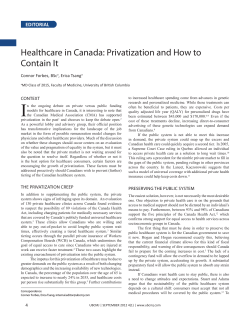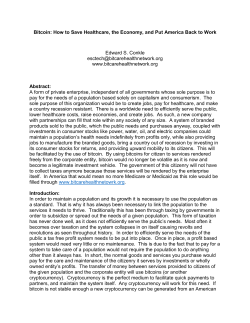
Document 196176
eHealth for Health in France How to cope with national & EU context and priorities Michèle THONNET Ministry of Health, Paris, FRANCE Bucarest 2011-05-26 1 Outline the french system characteristics challenges of the Health system the need for a reform : ICT lever The french policy developping a strategy eHR, ePR & eMR importance and roles launching a plan implementation /deployment challenges ‘Stop & Go’process & Lessons learned 2 FR engagement in EU / international world The french system global status France has a traditionally high-Q level of care WHO survey life expectancy 82 years main characteristics of french health : – mortality rate: a low infant, very low for elderly – a particularly wide gap in risk of death (M&W) – an correct situation concerning cardiovascular diseases but a weakness concerning premature 3 mortality & some territorial inequity Global cost of Healthcare % of GDP around 10 % with more than 1.7 million jobs global expenditure on health per capita about 2000 € average IT budget of French enterprises 5 % hospitals IT budget around 1.8 % (new 2012 hospital plan) IT savings : need for a business model saving on paper procedures is unconvincing 4 The french organisation : a complex system Free of charge universal service A multitude of actors – health insurance (compulsory, complementary ) – 300 000 professionals (120 000 doctors), – 23 000 pharmacies , 4 000 (biology) laboratories – 4000 hospitals, 1.7 million employees (50 000 doctors) …with a very large autonomy & a great impact on global economy 5 The key health actors in France National • Ministry of Health & national organisations (from public agencies to competence centres) Regional Healthcare : hospital/Health regional agencies ([ARH]-ARS) Health insurance : regional bodies [URCAM/CRAM] GPs/specialists : regional professional unions: URML, UNPS Public hospitals cooperation groupments for IT Local Hospitals : private public structures Health Insurance : local bodies (CPAM) Physicians and healthcare professionals 6 Reforming the H system : a necessity Demographic changes : ageing population increased prevalence of chronic diseases citizen expectations for high Q HC increasing costs of research, equipments, examinations, treatment quicker pandemia expansion lack of staff & shortage of HCP mobility of citizens, patients, HCP, workers 7 mastering costs : crisis & ‘business’ model ICTs : Key expectations Facilitate access, continuity of HC (mobility) Improving Q of care, allowing real HC equity Enhancing coordination, continuity of care security & safety Facilitating collaboration between HCP, within/between HCPO Improving homecare & adapted delivery services at PoC Organising mutualisation & intern. standards usage Facilitating research, L S experimentations & deploymt Decreasing the number of doubloning exam. 8 Mastering costs through innovative model(s) ICT : necessary but not sufficient Increasing expectations of the citizens must be met - e-services part of the daily life internet penetration without borders free choice expectations availability of HC services Health must benefit from ICT as other sectors But reengineering with security, quality of care & safety fear (patients, HCP) must be overcome TRUST is key 9 The french strategy on e-Health ICT as an enabler for Health : in the law since 1996 as a first needed framework difficult Balance : – priorities vs urgencies – territorial levels & population size/ specific needs 10 A central objective : a Health strategy Use the contributions and facilities of the networks ( technical, medical ) : i.e. ICT to improve the healthcare system for a better citizen welfare improving the level and the quality of care including the control of the costs 11 Three types of projects / programmes 1. a first stage : SESAM-Vitale – administrative simplification for refunding health expenses (citizens/patients focus) 2. public Health issue – to manage the consequences of the availability of new flows of information to the public (education, protection) 3. a « corner stone » project to improve the doctor-patient relationship : – electronic health record (EHR) ; to the ePMR 12 Four main objectives 1. To facilitate the continuity and the coordination of the health care : – reorganisation of the points of care (telemedicine, ...) – enhance information exchanges (electronic health records : protected access and transmission) 2. To improve access to info & knowledge : – online state of the art for the professionals ( KB, EBM) – quality of e-health sites (URLs, forums ??) 13 Four main objectives (2) 3. Better know the reasons for recourse (to care) and evaluate the expenditure – organise & pilot via up-to-date information system(s) 4. Administrative simplification SESAM-Vitale – better and quicker refunding – dematerialisation of the administrative flows (for patients & HCP) 14 – design new services (« web doctor ») The deployment scenario Build on the last objective : SESAM-Vitale but reuse the investment already done on this first structuring application for the other priorities The linkage of administrative support systems to care production and logistics systems is essential 15 Some outputs & feedback SESAM-Vitale : First difficult step (IGAS report) – Standardisation (Hard/Soft) – PC & HCP – Network availability – Security issues (on internet) – ‘stakeholder’ involvment (HCP) – human resources availability & training – To be paid for : equipment / messages exchange / access / ready to use / adoption16 SESAM-Vitale today’s picture : a success First national ‘HC’ application : administrative simplification & procedure acceleration: Reimbursement in 5 days for citizens Accessible from any PoC by authenticated HCP Buiding on a national secured infrastructure : secured network and authentication process (citizens & HCP) 17 Paving the way for the new phase : medical applications Supporting Large Scale Pilots « e-sante » projects (10 M euros 2000-2002) : communication between hospitals and HCPs-100 pilots Hospitals IS : « Hôpital 2007 » plan – 320 M euros/80 pilots focused on hospital care processes and regional communication systems Primary HCPs and healthcare networks : FAQSV (fund for the quality of primary healthcare) managed by the health insurance national and regional bodies Pilot for shared patient electronic record : implementation in 2005 (1 M patients) 18 ICT : beyond simplifying adm & reimbt an enabler for transforming HC Better health status for the population – Enhance level & Q of care within « mastering » costs 2 major levers : – Give access to the state of the art K – Facilitate transmission, storage, access medical data, K Need to overcome barriers – ICT: a tool to « re-balance » the respective roles (P, HCP,…) Give more freedom to stakeholders – Internet : a major progress engine without borders But not a place of non-right – Need to protect individuals & control the status of info 19 delivered Legal framework national programmes & public evaluation 1996 Ordo. Juppe (CPS, SESAM-Vitale) – IGAS report (Gubler, Dessaint, Thonnet): Dg and Reco on SESAM-Vitale 2002 patients rights 2004 HC & SS reform : DMP & telemedicine – DMP ( 07/2007 deadline in the law) 2007 DP, Hospital 2012 plan, Telemedicine report – 2007/11 join IGF-IGT-IGAS report (5 co-authors): Dg, challenges, Reco on DMP – 2008/04 IGAS report (Gagneux & 7co-authors) : the DMP relaunch proposal 2009 law « Hospital, Patient, Health & Territory »(HPST): – reorganise the regional & local responsibilitiess (ARS), relaunch DMP (ASIP), propose a Telemedicine framework 20 2010 eHealth at the political level ; telemedicine decree The DMP exemple: created by law 2004 Deployment Short term ROI on economic basis ‘Semantic’ More date written in the law shift between DM(P) & DM[P] focus on technical challenges than on medical issues 21 The DMP’s context opportunities Short deadline is nevertheless appropriate to – – – – – – – Create a dynamic team & structure Reveal volountary co-operation Organise concertation & mutual understanding Clarify respective roles & responsibilities Facilitate communication, exchanges Pave the way for « sharing » & change managt Reveal the continous education& training needs Identify a medical information exchange dynamic based on the « patients needs » 22 DMP : GO / No GO decision Beyond deadline & Political changes Evaluation process : opportunities to build upon – National importance of the project – Structural components for the health organisation system – A set of promising / reusable outputs – ICT lever recognition – Collaborative process on the way 23 DMP relaunch new principles First to enhance Q+ continuity of care – for authorised HCP by design – Useful for HCP & patients (Kouchner law) Technological choices must serve the usage Progressive evolving content, infrastructure Visible, realistic & flexible timeline Clarification of targets, strategy, ‘highways’ Adequate balance usability / privacy 24 Efficiency & consistency of the governance The DP exemple 2007/01 Pharmaceutical care record (DP) creation in the SS law 2007/08 first pilots in some volountary regions & pharmacists 2010/06 : 3 more steps ‘ready-in-useadopt on daily basis’ 16000 pharmacies ; 8.5 M DP 25 The key factors of success • To join forces of all the concerned actors – Appropriation & usage of the developed tools – Convergence with the (nat/reg) existing systems – Progressive moving to consensual target – Call for M.S. information/ experiences exchanges & collaboration • To organise continuous cooperation • with the users, payers & industry 26 A way to progress design an iterative process – existing adopted roadmap & context evolution – conditions of generalisation & sustainability not forget to nominate A pilot – strong coordination & clear decisions – be compliant with subsidiarity principle do be precise in respective roles & liabilities27 French MoH : Mr Xavier BERTRAND Build upon existing secured infrastructure 1996 laws (SV) ; 2002 ( patients rights), 2004 (HC reform, secured medical data repositories), 2007(DP), 2009 (HPST) 2008/11/04 + 2009/04/09 eHealth at political level – Define a clear strategy – Enhance motivation & coordination of actors – 4 pillars for ehealth : • • • • Modernisation of HIS (H2012) Relaunch ePR (shared personal medical record): 01/2011 deploymt Legal framework & conditions for telemedicine (HPST art L 6316-1) Organise the global governance (include stakeholders):DSSIS An absolute priority : privacy, security & confidentiality 28 Potential success factors Interrelated & complementary HC strategy – Overall approach C, P, Family, HCP, HCPO, SociaI dimension, SDO,I.. Increase Legal certainty – design legal framework aligned with new ICTs capabilities Key human leadership : – encourage networking, mutualisation, re-usability, – presence of grass root initiatives, dedicated managers, physicians leaders, engaged empowered patients & citizens Design a basket of incentives – appropriate allocation of resources based on mix of stategies : compensation rewarding Q + Perf (not « volume ») Capability to design & deploy new flexible innovative sustainable models 29 Keep open to the ‘outside’ world involve the concerned actors since the beginning improve & facilitate the use of standards [european & international ] avoid to focus too much on technical issues keep targets and deadlines realistic anticipate 30 – negative consequences of a new system or FR-EU co-operation : Health in the EU Treaty HEALTH is a national prerogative – subsidiarity is key – but challenges are the same in each M.S. what could be done at EU level : – a volontarist collaboration between M.S. – supported by the E.C. – confirmed by the « eHealth action plan » – design through a dedicated organisation – declined on pragmatic priorities 31 2002-2010: a new era in legal and policy framework for EU Cooperation on eHealth Communication on Quality critera for a web site Communication on the eHAP Recommendation on cross-border interoperability of electronic health record systems Communication on telemedicine for the benefit of patients, healthcare systems and society eHealth Standardisation Mandate 403 – ------------------------------------------------------------------------------------ EU Council conclusion on safe and efficient healthcare through eHealth – December 2009 Adoption of the Directive on patients’ rights in crossborder healthcare - 2011 32 other EU current initiatives Health – Europe 2020 : “Sustainable health”; – Innovative Union : EIP AHA Standardisation – Digital Agenda for Europe – IT Standardisation eHealth M.S. and stakeholders voluntary cooperation – epSOS – CALLIOPE 33 – eHealth High Level Governance eHR Modelling: an input for collaboration (2007) 34 Interoperability RECOMMENDATION REVIEW – Interoperability is considered for the purpose of “integrated, connected and interoperable continuity of care for Europe”: • • • • Political Organisational Semantic Technical/standardisational 35 35 epSOS – a highly political project Member State obligation to deliver the best possible medical treatment – at home or when travelling Introducing a new dimension in national healthcare systems Goal for the epSOS eHealth Project: – “to develop a practical eHealth framework and ICT infrastructure that will enable secure access to patient health information, particularly with respect to a basic patient summary and ePrescription, between European healthcare systems” Main political objectives: – support patient mobility nationally and in the EU – ensure that patient safety is guaranteed – increase efficiency and cost-effectiveness in cross-border care 36 The Roadmap The needs – service innovations needed to focus on existing or anticipated health care system priorities a vision – of where we wish to go and what solutions are needed to get there a route for achieving the vision – to select and develop the right alternatives needed to create the right services 37 AN EU eHEALTH INTEROPERABILITY ROADMAP What: possible future actions at EU level For what: To accelerate ehealth deployment Who: Health care community WHERE? FOR WHAT PUPROSE? WHO BENEFITS? WHAT’S AT STAKE? How: Use Cases, alternatives, maturity and opportunities, building on what is shown to work 1st stop Barcelona validation 2nd step Mai 2011 Budapest EU interoperability Roadmap progress A proposal for a common EU Roadmap for eHealth 38 The process Roadmap versioned documents Roadmap Consolidation workshops CALLepSO workshops SDOs X-border project consultations eID,semantics 39 Collaborative evolving process Political priorities 2ndstop Budapest, Mai 2011 Agreement and validation of the Roadmap by the Secretaries of State Stakeholder priorities Reaching agreements through continuous bench-learning loop across concerned actors 40 Adoption of a common working model Sustainable Healthcare Sharing Information and Knowledge for Better Health eHealth eHealth leadership, Governance e.g., Data analysis & aggregation Knowledge management, etc. Other national priorities Rare diseases Community services, AAL Chronic Care Management Electronic prescribing Patient summaries Common EU priorities policy and strategy EU & National Stakeholder collaboration Privacy, quality and safety policies National priorities Foundation eHealth infostructure Patient identification and patient data discovery HCP Authorization, authentication and rights management Clinical terminologies and classifications and codifications Consent management and access control Data structures and value sets EHR, EMR, PHR, other Data and knowledge management tools Data interoperability and accessibility Data bases and Registries Foundation ICT infrastructure Mobile and fixed Electronic Communication Infrastructures Access to ICT Networks, equipment and facilities ICT processing and storage services ICT Professional and technical support; Training Legislative and regulatory framework Fostering standards adoption Market development, new business models, and incentives Financing, Resource allocation and reimbursement models Monitoring, evaluation 41 41 Recommendations and Outlook propositions provide concrete input to decision making support of the eHealth high level governance process www.calliope-network.eu Political priorities 42 Directive on patients rights in cross border Healthcare: eHealth article (14) 1. The Union shall support and facilitate cooperation and the exchange of information among Member States working within a voluntary network connecting national authorities responsible for eHealth designated by the Member States. 2. The objectives of the eHealth network shall be to: (a) work towards delivering sustainable economic and social benefits of European eHealth systems and services and interoperable applications, with a view to achieving a high level of trust and security, enhancing continuity of care and ensuring access to safe and quality healthcare; (b) draw up guidelines on ▌: (i) a non-exhaustive list of data that are to be included in patients' summaries and that can be shared between health professionals to enable continuity of care and patient safety across borders, and (ii) effective methods for enabling the use of medical information for public health and research; (c) support Member States in developing common identification and authentication measures to facilitate transferability of data in cross-border healthcare. 43 European eHealth Governance levels Policy level: to set out higher level political objectives, define common priorities and policy measures Strategic level: to agree on concrete strategies for developing and implementing integrated, value adding eHealth services Establishment and maintenance of an open platform for multi-stakeholder trusted dialogue Operational level: deeper focus in areas such as ethics, security policies and services, EU infostructure, re-engineering of the standardisation process, maintaining links to national stakeholder groups, etc. 44 A further consolidated approach is needed Establish a European Governance to sustain an open and transparent process involving all three levels Reach out to the national communities, i.e. beyond what CALLIOPE was able to achieve within its life span Establish mechanisms to support MS in their implementation of the EU Roadmap 45 The eHealth High level Governance Initiative Thank you for your time Think globally Act locally Michele.THONNET@sante.gouv.fr 46
© Copyright 2025




















